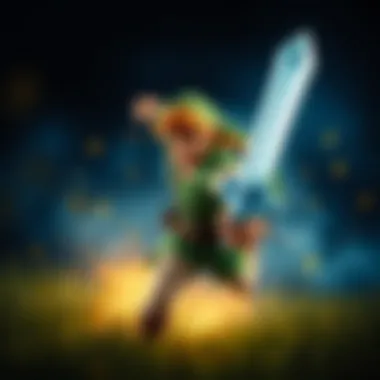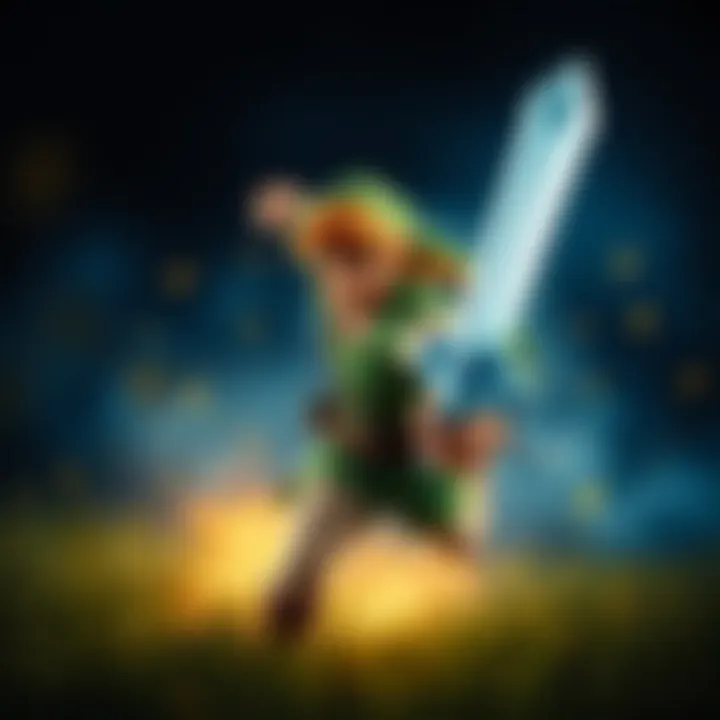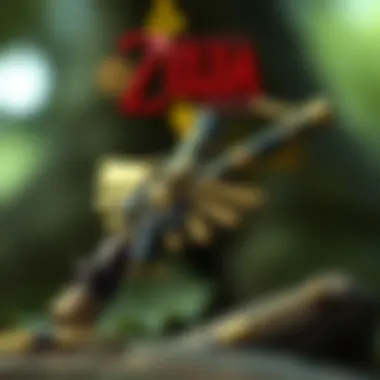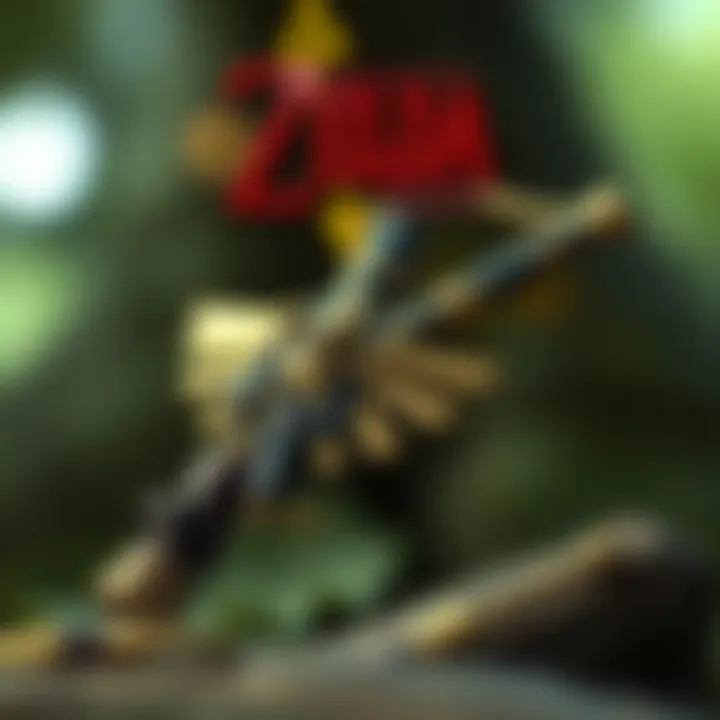In-Depth Exploration of Nintendo's Ocarina of Time


Intro
Nintendo's Ocarina of Time, launched in 1998, holds a special place in the hearts of gamers across generations. This action-adventure game not only defined a genre but also became a pivotal milestone in gaming history. The experience it offers is rich, layered, and often described as transformative, impacting how stories are told and how players interact within a virtual world.
As we embark on this comprehensive analysis, we will touch upon various facets of Ocarina of Time. From gameplay mechanics that introduced innovative elements, to its storyline that dances between simplicity and profound themes, this article seeks to paint a vivid picture of why this title remains relevant today. Additionally, we will explore the game's distinct graphics, haunting soundtrack, and the legacy it has carved out in the gaming industry.
There’s no denying that this epic journey through Hyrule, where players assume the role of Link, continues to spark discussions and reflections nearly three decades post its release. The following sections will delve deeper, helping casual fans and dedicated enthusiasts alike appreciate the multifaceted brilliance that Ocarina of Time embodies.
Historically speaking, the game was revolutionary, not just in terms of technology, but also on a narrative front. As we dissect gameplay, characters, and critical receptions, one theme resounds – Ocarina of Time has left a mark on modern gaming that is as significant as it is enduring.
Preamble to Ocarina of Time
The introduction of Ocarina of Time serves as a gateway into one of the most celebrated titles in video game history. To grasp its significance, it’s essential to understand not only the foundations of its gameplay mechanics but also the cultural tapestry it sits within. Ocarina of Time isn’t simply a game; it’s a touchstone in the realm of action-adventure gaming that shaped the expectations of players and developers alike. This section will provide a thorough examination of the game’s overview and its substantial role within the Nintendo lineup.
Overview of the Game
Nintendo's Ocarina of Time debuted in 1998 on the Nintendo 64, marking a revolutionary leap in gaming. The title blended engaging story and seamless gameplay, setting a gold standard for what players could expect from their interactive experiences. Players are guided through the land of Hyrule as Link, tasked with thwarting the dark intentions of Ganondorf. The game incorporated RPG elements, non-linear storytelling, and real-time combat, all wrapped up in a rich narrative that dives deep into themes of courage, friendship, and the passage of time.
One cannot overlook the innovative use of 3D graphics and expansive environments, which placed players right in the heart of Hyrule. Details like fluid animations and dynamic shadows weren’t common in gaming at the time, paving the way for future installments in the genre. The core gameplay mechanic revolves around the ocarina, an in-game musical instrument that allows Link to influence the world around him—altering time, summoning rain, and unlocking special abilities. These mechanics added layers of complexity to the gameplay, inviting players to explore every corner of the game thoughtfully.
Significance in the Nintendo Franchise
The release of Ocarina of Time solidified Nintendo’s prowess in the gaming industry, especially following the success of earlier titles like Super Mario 64. It not only impressed players but also elevated the expectations for all future action-adventure games.
This game is widely regarded as a benchmark, often appearing at the top of various “greatest games of all time” lists. It set in motion what would become a thriving Zelda franchise, with characters and themes that have been woven into the broader Nintendo lore. Beyond its financial achievements, it’s notable for receiving unprecedented critical acclaim upon release, winning multiple Game of the Year awards.
The impact of Ocarina of Time stretches from influencing game design to nurturing a legion of loyal fans, including developers who grew up playing it. Its music, characters, and gameplay elements have become quintessential aspects of any conversation about video gaming's evolution. As a cornerstone of the Nintendo franchise, its legacy lives on, underscoring its undeniable importance in both the company's history and the broader gaming narrative.
"Ocarina of Time helped to redefine gaming, making complex narratives and 3D environments a staple for future generations.*"
In sum, Ocarina of Time is more than a nostalgic piece of everyone's childhood; it lays the groundwork for what action-adventure games can be, shaping both the Zelda series and the expectations for video game storytelling at large. The lasting influence of this title is evidenced in the dedication of its fanbase and the continued relevance of its themes and mechanics.
Development History
The journey of Ocarina of Time doesn't just begin from its initial release but finds its roots in a rich tapestry of development history. Understanding the significance of this topic provides insight into the creative minds that shaped the game and the technological landscape of its time. The development of the game highlighted innovative ideas, collaborative efforts, and the sheer determination against challenges, which collectively contributed to its status as a groundbreaking title in gaming history.
Key Figures in Development
In the world of gaming, certain names resonate with unmistakable weight, and during the development of Ocarina of Time, few stand out as much as Shigeru Miyamoto and Eiji Aonuma. Miyamoto, often referred to as the father of modern gaming, was instrumental in crafting the concept of the game. His vision blended elements from previous projects like The Legend of Zelda: A Link to the Past and a newfound desire to create a 3D world that felt both expansive and immersive. Aonuma, though initially joining as an assistant, eventually took the helm as director and nurtured the game's development, particularly focusing on its narrative depth and character arcs.
Both figures brought forth a wealth of creativity and experience, ensuring that each pixel, sound, and storyline adheres to the high standards set by previous Nintendo titles. Their teamwork, influenced by a culture that cherishes innovation, served as a driving force that shaped the game into what it is today.
Technological Innovations of the Time
Launched in 1998, Ocarina of Time utilized the Nintendo 64, a console that was making waves due to its leap into 3D graphics. This advancement was not just a casual upgrade; it was akin to stepping off a train at a bustling, modern station when the last stop had been a quaint, old-timey depot. Features like Z-targeting, which allowed players to focus on enemies effortlessly, completely revolutionized the way combat felt. This innovation made encounters smoother and more engaging, setting a precedent for future titles in the action-adventure genre.


Moreover, the game's expansive world was made possible through a blend of creative map design and a sophisticated engine that catered to detailed environments and dynamic interactions. Players could explore Hyrule, jump on rooftops, and unlock puzzles in a manner that had previously been almost unimaginable. The world of Ocarina of Time didn't just feel like a game but rather a living, breathing place.
Challenges Faced during Development
The road to creating Ocarina of Time wasn't all sunshine and rainbows; it came with its set of hurdles. One of the most significant challenges was the ambitious goal of crafting a 3D open world. Upon initiation, Nintendo's development team faced doubts about whether the technology at hand could support the expansive world they envisioned. They pushed boundaries; the result was a grueling yet rewarding process.
There were also time constraints that pushed the team into overdrive as they worked to meet deadlines while trying to avoid the pitfalls of previous launches. Balancing creative ambition with practical limitations required relentless effort and ingenuity. In the end, though fraught with trials, the labor paid off tremendously, leading to a game that was not only critically acclaimed but would go on to inspire generations of developers and gamers alike.
"The creation of Ocarina of Time is a testament to the creative spirit of Nintendo. It was a blend of challenging tech, visionary ideas, and passionate craftsmanship."
In summary, the development history of Ocarina of Time encapsulates the essence of a team dedicated to pushing the envelope of what video games could achieve. Through the influence of key individuals, the utilization of technology, and overcoming challenges, a masterpiece was born that continues to resonate within the gaming community.
Gameplay Mechanics
Gameplay mechanics are the backbone of any video game, especially in an action-adventure title like Ocarina of Time. These mechanics are not just technical details; they create the framework through which players interact with the game world. Understanding the core elements, benefits, and considerations surrounding these mechanics can elevate one's appreciation of this classic title, from casual players to seasoned veterans.
Core Mechanics and Controls
In Ocarina of Time, core mechanics revolve around movement, combat, and interaction with the environment. The controls are designed intuitively, allowing players to run, jump, and interact fluidly with the world of Hyrule. The game introduced a targeted locking system, known as Z-targeting, which allows players to focus on enemies or objects in their vicinity. This system was revolutionary, as it took the frustration out of combat and exploration. Players could engage foes more effectively without the risk of missing their mark.
By mapping actions to the C buttons, Nintendo ensured that accessing items was straightforward. For instance, players could quickly switch between Ocarina, bows, and bombs as needed, providing versatility in gameplay. The seamless integration of these controls allowed newcomers to dive right in, while experienced players could refine their skills.
Puzzle Design and Complexity
Puzzle design in Ocarina of Time is a hallmark of its gameplay mechanics. The developers took great care to create a diverse range of challenges that reflect the game’s overarching themes of time and adventure. Dungeons are filled with intricate puzzles that require critical thinking and observation.
- Layered Puzzles: Many puzzles involve multi-step solutions, encouraging exploration and creativity. For example, players often need to obtain specific items or use the environment to their advantage. This can mean manipulating light with mirrors or even using the Ocarina to change the day or night cycle, thereby unlocking secrets.
- Variety in Mechanics: Different dungeons introduce unique mechanics, such as the Water Temple, where managing water levels becomes a central challenge. This encourages players to adapt to new environments and think outside the box, offering a fresh experience in each dungeon.
Combat System Analysis
The combat system in Ocarina of Time provides a perfect blend of challenge and accessibility. With both melee and ranged options, players can engage enemies with swords, bows, or even magical items. The enemy encounters are strategically designed, increasing in complexity as the game progresses.
- Enemy Variety: From the common Bokoblins to the formidable Dark Link, each enemy type requires different strategies to defeat. Understanding their patterns allows players to exploit weaknesses, further enriching the combat experience.
- Skill Development: As players advance, they can upgrade their weaponry and learn new abilities through experience. This aspect of progression fosters a sense of accomplishment and motivates players to refine their combat skills.
"The true beauty of combat lies not in raw power, but in the ability to respond fluidly to each unique encounter."
Narrative Structure
The narrative structure of Ocarina of Time plays a pivotal role in not just engaging players, but also in crafting an experience that feels like a grand adventure. This structure acts like a thread weaving together various gameplay elements, character arcs, and thematic explorations, creating a rich tapestry that players immerse themselves in. A well-thought-out narrative elevates the medium from mere entertainment to an art form, drawing players into a world where they feel emotionally invested in the outcomes of their actions.
Plot Overview
At its core, Ocarina of Time presents the classic tale of good versus evil, centering on the hero, Link, tasked with thwarting the wicked plans of Ganondorf. The plot unfolds through a mix of quests, puzzles, and battles that span across multiple locations in the land of Hyrule. Players witness Link's transformation from a timid boy in Kokiri Forest to a courageous warrior destined to save Princess Zelda and restore peace. This journey is structured in a way that allows for exploration and discovery, where every nook and cranny of Hyrule reveals bits of lore, side quests, and items crucial for progressing through the game.
The nonlinear approach to gameplay—completing dungeons in various orders, tackling side quests, and engaging with different characters—ensures that players feel a sense of agency in shaping Link's adventure. This remarkable flexibility within the narrative allows individual experiences to differ vastly, a hallmark of excellent game design.


Character Development
Character development within Ocarina of Time is not just a side thought; it is a driving force behind player engagement. The characters grow, not just in strength and abilities, but also in depth, offering players a chance to connect emotionally. Link, often seen as a silent protagonist, conveys a spectrum of emotions through actions and interactions rather than dialogue. On the other hand, Princess Zelda evolves from a mere damsel in distress into a strong figure who plays a crucial part in overthrowing Ganondorf. Her dual identity as Sheik adds further layers to her character, challenging players’ perceptions of gender roles and heroism.
Supporting cast members like Navi, the ever-helpful fairy, and King Zora, who embodies the nobility of his people, enhance the narrative further. Each character contributes to the grand narrative by providing essential insights, lore, and sometimes, comedic relief, creating a balanced approach to character dynamics.
Themes Explored in the Game
Various themes are intricately woven throughout Ocarina of Time, providing deeper philosophical reflections beyond just gameplay mechanics. Notably, the themes of courage, the passage of time, and the struggle for power resonate strongly. Courage is the central virtue embodied by Link; he must confront his fears and fight against overwhelming odds to fulfill his destiny. The game also plays with the concept of time in a literal sense—players manipulate time through the titular ocarina, an instrument that not only shapes the world but also underscores the importance of choices and consequences. This manipulation speaks to the transient nature of life and the pivotal moments that shape who we become.
Moreover, the battle against Ganondorf illustrates the age-old conflict of good versus evil, emphasizing how one’s choices can lead to light or darkness. These themes elevate the gameplay from simple quests to profound journeys about self-discovery and moral decisions, making the narrative both compelling and thought-provoking.
"Ocarina of Time isn’t just a game; it's a narrative experience that challenges players to engage with its story on multiple levels, blending gameplay and storytelling seamlessly."
The combination of these plot elements, character developments, and recurring themes create a robust narrative structure that remains influential and relevant in the realm of video games today.
Visual and Audio Design
The visual and audio design of a video game is not merely an aesthetic consideration; it serves as the very heartbeat and soul of the gaming experience. In "Ocarina of Time," these elements intertwine to create an immersive experience that draws players into the world of Hyrule. It's the careful balance of visuals and audio that not only establishes the mood and atmosphere but also enriches gameplay, aiding in storytelling and player engagement.
Art Style and Graphics Evolution
When "Ocarina of Time" debuted in 1998, the gaming landscape was undergoing a remarkable shift. The transition from 2D sprites to 3D environments was no small feat, and Nintendo embraced this evolution wholeheartedly. The game’s art style, characterized by its distinctive blend of cartoonish aesthetics and a richly detailed world, played a crucial role in presenting both gameplay and story.
- Character Design: From Link’s iconic tunic to the intriguing designs of the various NPCs, characters are well-defined and instantly recognizable. This clarity allows players to forge connections with the characters in their quest to save Princess Zelda.
- Environmental Graphics: The expansive landscapes of Hyrule showcase a variety of biomes, from dense forests to arid deserts. Each setting is visually distinct, enabling players to feel a sense of progression and exploration. Additionally, the lighting effects, particularly during the transition between day and night, add a layer of realism that deepens immersion.
- Graphics Evolution: Comparing the graphics of "Ocarina of Time" to earlier titles like "Super Mario 64" reveals significant advancements. While the latter laid the groundwork for 3D exploration, Ocarina refined these concepts, introducing more complex textures, environmental interactions, and atmospheric effects. Such evolution not only enhanced gameplay but also set a visual standard for future action-adventure titles.
Soundtrack and Audio Effects
The audio component of "Ocarina of Time" is equally investment-worthy, with a soundtrack that has become iconic in its own right. Composed by the legendary Koji Kondo, the music encapsulates the essence of Hyrule, enhancing emotional engagement and providing cues that guide players throughout their journey.
- Musical Themes: Each location in the game boasts its own musical theme. For instance, Kakariko Village’s serene melody evokes a sense of home and safety, contrasting with the haunting tunes of the Shadow Temple. Such musicality not only reinforces the atmosphere but also serves as a narrative device, indicating the emotional context of a scene or environment.
- Sound Effects: The impact of sound effects should not be overlooked. The clinking of Link’s sword, the boisterous roars of enemies, and the soothing notes of the ocarina itself contribute to a richer gameplay experience. These auditory cues provide feedback, helping players discern successful actions or alerting them to nearby dangers.
- Cultural Significance: The soundtrack has transcended gaming, appearing in orchestral concerts and remix albums, illustrating its broad effect on popular culture. Players often cite the songs from Ocarina, like the Song of Time or the Zelda’s Lullaby, as melodies that evoke nostalgia and fond memories.
"The music and sound in 'Ocarina of Time' give players not just background noise, but a direct hand in creating unforgettable moments in their journeys."
In sum, the visual and audio design of "Ocarina of Time" are not merely embellishments; they are critical components that shape player experience. Together, these elements forge an unforgettable atmosphere, crafting a world that lingers in the hearts and minds of gamers long after they've put down the controller. For anyone examining the legacy of Nintendo's work, it’s impossible to overlook how these features have helped to set the gold standard for not just action-adventure games, but video games as an art form.
For further insights and discussions on this iconic title, refer to sources like Wikipedia and community discussions on Reddit.
Cultural Impact
The cultural impact of Nintendo's Ocarina of Time cannot be overstated. As a game that revolutionized how stories are told within the realm of video gaming, it has had a lasting effect on both the industry and its audience. This section delves into the multifaceted ways in which Ocarina of Time has influenced gaming culture and the larger media landscape.
Reception and Critical Acclaim
Upon its release in 1998, Ocarina of Time was met with overwhelming critical acclaim. Reviewers praised its innovative gameplay, engaging narrative, and immersive world. This admiration can be seen in the scores it received from various gaming publications, often earning perfect or near-perfect ratings. The GameSpot review, for instance, heralded it as a "masterpiece that defines a generation," while IGN declared it as "the best game ever made" when first assessed. Such high praise cemented its status within the community and set a benchmark for future titles.
Public reception mirrored critical admiration, as millions of copies flew off the shelves, making it one of the best-selling games of its time. Its ability to resonate with both long-time fans and newcomers helped it gain a devoted following.
Moreover, the game's innovative mechanics, particularly the 3D lock-on targeting system, was a first for action-adventure titles and has since been replicated in countless games. This contribution wasn’t merely technical; it represented a shift in player interaction and narrative experience that continues to inform design principles today.
Influence on Other Titles
The legacy of Ocarina of Time is evident in the many games that followed. Titles like Dark Souls and The Legend of Zelda: Breath of the Wild draw heavily from its heritage, incorporating its rich narrative structure and gameplay design into their own frameworks. The emotional stakes presented in Ocarina of Time — where the fate of Hyrule hinges on Link's journey — set a precedent for narrative depth in gaming.
Additionally, its open-world format inspired many developers to use a similar approach, leading to expansive environments filled with quests and lore that players could explore at their own pace. This implementation of player agency, combined with an intricate storyline and engaging puzzles, has become a gold standard across various genres. In essence, Ocarina of Time became a touchstone for what constitutes a compelling and immersive game.
Presence in Popular Culture
Beyond the gaming world, Ocarina of Time has made its mark on popular culture. The game’s iconic themes, characters, and motifs have been referenced in films, television shows, and other forms of media. From parodies in shows like The Simpsons to covers of its soundtrack in orchestras and amateur performances, the reach of its influence is extensive.
Furthermore, fan art and cosplay celebrating Link and Zelda are commonplace at conventions, epitomizing the game's status in the geek culture landscape. This cultural integration speaks volumes about the game’s emotional resonance and the community it spawned.
In a world where many games come and go, Ocarina of Time's legacy remains, shaping the very essence of what it means to be an enduring classic.
In summation, the cultural impact of Ocarina of Time is a testament to its ability to connect with audiences on multiple levels, making it not just a game, but a cultural phenomenon that continues to thrive decades after its original debut.
Legacy and Continued Relevance
The legacy of Nintendo's Ocarina of Time is broad and impactful, resonating deeply within both the gaming community and the industry as a whole. Its continued relevance can be observed through various avenues, from remakes keeping the title alive in modern gaming to the ways communities engage around it. The ripples from its initial release are felt even today, as aspects of its design, storytelling, and gameplay can be seen echoed in countless titles that followed.
Remakes and Remasters
Remakes of Ocarina of Time breathe new life into the classic. The most notable example is the Ocarina of Time 3D for the Nintendo 3DS, which enhanced graphics and made use of the handheld's capabilities while maintaining the original game's core essence. Players experience the familiar narrative, but the visual upgrades and refined controls invite both nostalgia for older gamers and accessibility for newcomers. This version introduced features such as enhanced character models and updated environments, highlighting how technology can enhance the foundational elements of a game without losing its original charm.
Moreover, the occurrence of fan-made remasters is noteworthy. Projects like Ocarina of Time: Unreal Engine showcase the passion of fans who are willing to invest their time in bringing this beloved game into more advanced graphics engines. These projects not only serve as tributes but also keep the conversation surrounding the game active, implying that the essence of Ocarina of Time lives on through its community.
Ongoing Community Engagement
The Ocarina of Time community remains vibrant, marked by discussions, content creation, and multiplayer mods that keep fans engaged with the game. Platforms like Reddit host dedicated threads where players share tips, secrets, and speedrunning strategies. The interactivity among the fans showcases how the game continues to foster relationships among players, echoing the sense of adventure it instilled in its original context.
Further, YouTube and Twitch channels have flourished with content focusing on Ocarina of Time, whether through playthroughs, speedruns, or analytical videos. This content invites fresh perspectives and revisits the game's mechanics, creating a dialogue that adds depth to the game's legacy. The act of sharing gameplay experiences contributes to a wellspring of communal knowledge, reinforcing that Ocarina of Time is not just a game but a cultural artifact.
In summary, the legacy of Ocarina of Time is not limited to its initial acclaim or sales figures. Its ongoing relevance is evident through successful remakes and a thriving community that continually engages with its world. As gaming evolves, the foundational principles laid by Ocarina of Time endure, shaping how new titles are conceived and played. Continually, we see that this game isn’t merely a relic in a museum but a living part of gaming conversation.
The End
In wrapping up this exploration of Ocarina of Time, it’s crucial to recognize not only its landmark status in the world of video gaming but also the nuanced layers of gameplay, narrative, and cultural significance it has brought forth.
Final Thoughts on Ocarina of Time’s Impact
The profound influence of Ocarina of Time extends well beyond its release. Its pioneering mechanics, particularly involving the Z-targeting system, reshaped how action-adventure games approached combat and navigation. Players now could enjoy a refined experience, allowing for a level of engagement that was previously unattainable. Moreover, the orchestration of time within the narrative, where Link traverses between his childhood and adulthood, deeply resonated with players, embedding themes of growth and responsibility within gameplay. Today, we see echoes of its innovations in titles like Breath of the Wild, which takes the foundational lessons from its predecessor and expands upon them in a vast open-world environment.
"Ocarina of Time is not merely a game; it's a pillar that set the stage for what video games could aspire to be."
From its complex character development, especially through the journey of Link as he transforms from a naïve boy to a courageous hero, to its richly layered world that beckons exploration, Ocarina of Time remains a reference point. The emotional depth stirred by characters such as Zelda and Ganondorf further enriches its narrative, making it an exemplary model for storytelling in games.
Looking Forward to Future Nintendo Titles
As the gaming landscape continues to evolve, it is compelling to ponder how future Nintendo titles will take cues from Ocarina of Time. With each new generation of consoles and technology, the potential for more intricate storytelling, immersive gameplay experiences, and expansive worlds grows ever more promising. Titles inspired by the traditions laid down by Ocarina of Time not only carry forward the legacy but also afford new generations of gamers the opportunity to engage deeply with thoughtful narratives.
Nintendo’s knack for innovation guarantees that upcoming games will perhaps blend the beloved elements of nostalgia while integrating contemporary expectations of the gaming community. Perhaps we might anticipate further advancements in augmented reality or virtual reality that could push the boundaries of what players can experience in relation to in-game worlds and character relations. The excitement lies not just in what has been created but in the possibilities that await.
In the grand panorama of gaming history, Ocarina of Time serves as both a beacon and a blueprint, retaining its relevance and enduring legacy as gaming continues to unfold. Its impact is not just remembered; it’s felt, suggesting that as we look forward, the essence of Ocarina of Time will invariably inspire the next wave of game developers and storytelling enthusiasts.



